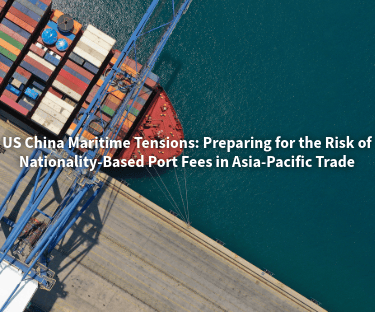US China Maritime Tensions and Port Fee Risk in Asia Pacific
US China Maritime Tensions: Preparing for the Risk of Nationality-Based Port Fees in Asia-Pacific Trade. Learn how potential geopolitical regulations could impact shipowners, charterers, and maritime finance, and what steps to take to protect vessel operations and asset value.
LawCite Advocates
10/10/20253 min read


Geopolitical Risk Advisory for Shipowners, Charterers, and Maritime Financiers
Rising tensions between the United States and China have created a credible regulatory risk for the global shipping industry. Industry analysts have warned that nationality based port fee regimes may be introduced in future trade retaliation measures. Although neither government has implemented such fees at this time, the commercial consequences would be immediate and significant if a nationality criterion were suddenly applied to port access and cost structures.
Maritime finance professionals, shipowners, and charterers operating on Asia Pacific routes should consider the exposure and prepare contingency plans before any such measures are announced.
Possible Structure of Future Port Fee Measures
If China or the United States were to introduce nationality based port charges, the regulatory framework could include:
Criteria based on the nationality of ownership, financing, or operational control
Fee tariffs applied to vessels linked to the targeted jurisdiction
Requirements for pre arrival declaration and advance payment before port entry
Denial of port clearance or entry for non payment
Limited exemptions based on repair calls or shipyard entry
This would represent a shift from traditional port regulation that focuses on flag or operational safety toward a model that focuses on political and financial links.
Cost Allocation in Maritime Finance Contracts
The primary commercial question created by such a regime is cost allocation.
Who would bear the burden of a nationality based port fee: the owner or the charterer?
Bareboat charter arrangements and finance lease structures often state that the charterer is responsible for all operating costs. However, a fee that is triggered by the nationality of financing or equity ownership is not linked to vessel operation but rather to the structure of asset ownership.
This creates a clear tension:
Charterers would argue that costs driven by financing arrangements should be borne by owners
Owners would argue that any port charges, regardless of political origin, relate to operation and therefore fall to the charterer
Standard form charterparties do not contain express language that resolves this question. If nationality based fees are implemented, disputes are likely unless documents are amended.
Operational and Safety Considerations
If advance fee payment becomes a condition for entry into ports, a new operational risk emerges. A vessel seeking refuge due to weather, mechanical failure, or safety concerns may face delay if payment has not been arranged. This would create a conflict between port safety obligations and enforcement measures related to geopolitical regulation.
This risk directly affects financiers, because the security value of a vessel depends on its ability to trade without barriers and to obtain safe refuge when necessary. Any impediment to port access must therefore be treated as a credit risk factor.
Impact on Covenants and Valuation
Nationality based port fees would also affect vessel economics. Regular trading into a targeted jurisdiction would become more expensive and vessel earnings may decline. Over time, this can reduce asset values.
Financing agreements that include Material Adverse Change provisions or covenants tied to trading cash flows may be impacted if:
Income deteriorates due to reduced trade access
Costs materially increase on certain routes
Asset values are written down as a result of geopolitical exposure
Lenders may respond through tighter covenant monitoring or higher risk pricing for vessels exposed to U.S. China trade routes.
Strategic Restructuring and Jurisdictional Neutrality
If nationality driven measures increase, financing structures based in neutral jurisdictions may become more attractive. Leasing and financing vehicles located in jurisdictions outside the United States and China could reduce exposure to regulatory retaliation.
This trend may drive restructuring of ownership and financing chains as a form of geopolitical risk mitigation.
Action Points for Maritime Stakeholders
Now is the optimal time to assess and prepare. Recommended steps include:
Identify vessels with U.S. or China ownership or financing links within your fleet or portfolio
Review charterparty and finance documentation for cost allocation gaps
Evaluate whether current covenant structures can absorb geopolitical fee impacts
Develop operational contingency plans for port entry compliance
Consider restructuring SPVs or financing parties to neutral jurisdictions
Monitor policy announcements and ensure legal teams remain engaged in developments
Include bespoke clauses in new contracts to address nationality based charges directly
These steps are low cost now but would prevent significant disruption if new fees are introduced with limited notice.
Conclusion
Nationality based port fees have not yet been implemented, but the level of trade tension between the United States and China means the risk is real. The implications extend into contract drafting, operational planning, asset values, insurance and credit underwriting. Preparedness during stable periods helps avoid urgent and costly decisions during a crisis.
Maritime stakeholders that proactively assess exposure and adjust documentation will be better positioned to manage future regulatory conflict in Asia Pacific shipping markets.
Target Audience:
The article is targeted at senior maritime finance professionals, shipowners, charterers, lenders, leasing companies, and legal compliance teams involved in structuring and operating vessels on U.S.–China or Asia-Pacific trade routes who need to prepare for emerging geopolitical regulatory risks affecting port access, cost allocation, and vessel valuation.
Address: - LawCite Advocates, Onlooker Building, 4th Floor, Office No. 32, Sir. PM Street, Opp. Axis Bank, Bora Bazaar Precinct, Fort, Mumbai - 400001, Maharashtra, India
Ph:- (+91) 9967318992
E :- contact@lawcite.in | vipinsharma@lawcite.in